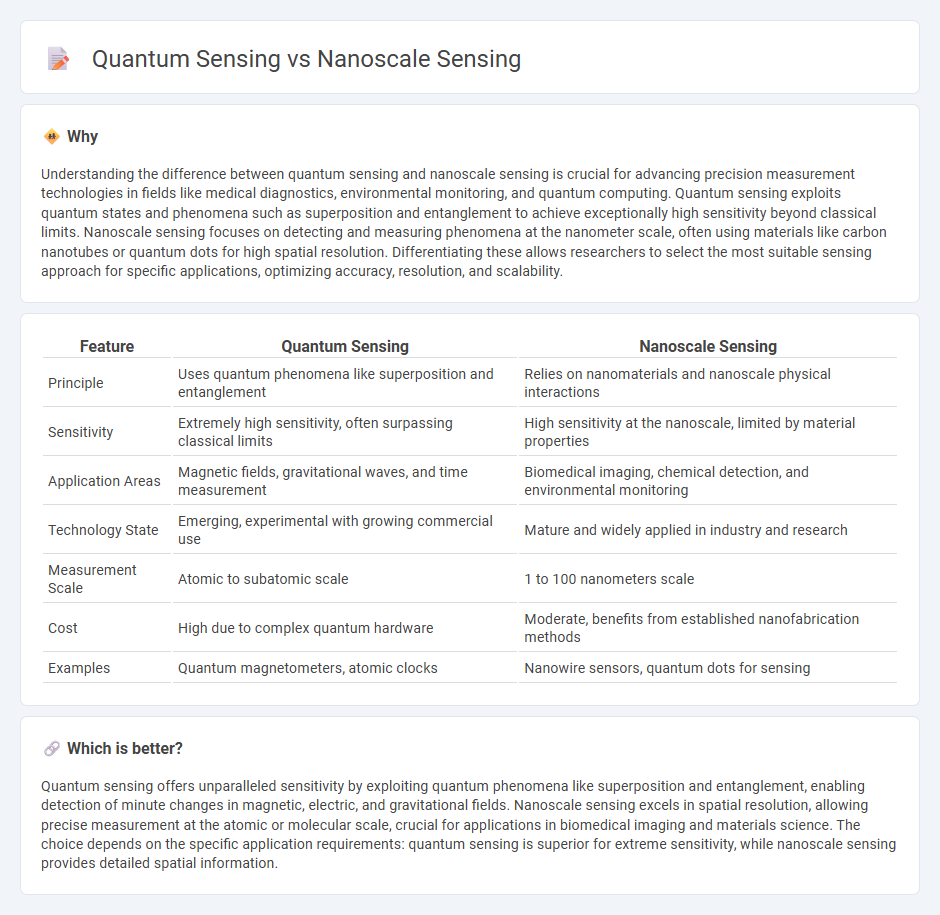
Quantum sensing leverages quantum phenomena such as superposition and entanglement to achieve unprecedented sensitivity and precision in detecting physical quantities like magnetic fields, temperature, and pressure. Nanoscale sensing utilizes nanomaterials and nanostructures to measure chemical, biological, and physical changes at the molecular or atomic level with high spatial resolution. Explore the advancements and applications distinguishing quantum sensing from nanoscale sensing for cutting-edge technology insights.
Why it is important
Understanding the difference between quantum sensing and nanoscale sensing is crucial for advancing precision measurement technologies in fields like medical diagnostics, environmental monitoring, and quantum computing. Quantum sensing exploits quantum states and phenomena such as superposition and entanglement to achieve exceptionally high sensitivity beyond classical limits. Nanoscale sensing focuses on detecting and measuring phenomena at the nanometer scale, often using materials like carbon nanotubes or quantum dots for high spatial resolution. Differentiating these allows researchers to select the most suitable sensing approach for specific applications, optimizing accuracy, resolution, and scalability.
Comparison Table
| Feature | Quantum Sensing | Nanoscale Sensing |
|---|---|---|
| Principle | Uses quantum phenomena like superposition and entanglement | Relies on nanomaterials and nanoscale physical interactions |
| Sensitivity | Extremely high sensitivity, often surpassing classical limits | High sensitivity at the nanoscale, limited by material properties |
| Application Areas | Magnetic fields, gravitational waves, and time measurement | Biomedical imaging, chemical detection, and environmental monitoring |
| Technology State | Emerging, experimental with growing commercial use | Mature and widely applied in industry and research |
| Measurement Scale | Atomic to subatomic scale | 1 to 100 nanometers scale |
| Cost | High due to complex quantum hardware | Moderate, benefits from established nanofabrication methods |
| Examples | Quantum magnetometers, atomic clocks | Nanowire sensors, quantum dots for sensing |
Which is better?
Quantum sensing offers unparalleled sensitivity by exploiting quantum phenomena like superposition and entanglement, enabling detection of minute changes in magnetic, electric, and gravitational fields. Nanoscale sensing excels in spatial resolution, allowing precise measurement at the atomic or molecular scale, crucial for applications in biomedical imaging and materials science. The choice depends on the specific application requirements: quantum sensing is superior for extreme sensitivity, while nanoscale sensing provides detailed spatial information.
Connection
Quantum sensing and nanoscale sensing are interconnected through their reliance on quantum phenomena to detect and measure physical quantities at atomic and molecular scales with unprecedented precision. Both technologies exploit quantum states such as superposition and entanglement to enhance sensitivity beyond classical limits, enabling applications in fields like medical diagnostics, materials science, and environmental monitoring. Nanoscale sensors integrate quantum sensing principles to achieve ultra-high resolution and sensitivity in compact, scalable devices.
Key Terms
**Nanoscale sensing:**
Nanoscale sensing exploits nanomaterials and nanostructures to detect physical, chemical, and biological changes at the molecular or cellular scale, achieving exceptional spatial resolution and sensitivity. Unlike quantum sensing, which leverages quantum coherence and entanglement to measure minute variations in fields and forces, nanoscale sensing primarily relies on the unique size-dependent properties of nanomaterials, such as enhanced surface area and quantum dots' fluorescence. Explore more about how nanoscale sensing transforms diagnostics, environmental monitoring, and precision medicine.
Nanomaterials
Nanomaterials enhance nanoscale sensing by providing high surface area, tunable electronic properties, and exceptional sensitivity for detecting chemical and biological agents at molecular levels. Quantum sensing leverages quantum phenomena such as superposition and entanglement in nanomaterials to achieve unprecedented precision and resolution beyond classical limits. Explore the intricate role of nanomaterials in advancing nanoscale and quantum sensing technologies for cutting-edge applications.
Surface Plasmon Resonance
Surface Plasmon Resonance (SPR) plays a pivotal role in nanoscale sensing by detecting changes in refractive index at the sensor surface, enabling high-sensitivity measurements at the molecular level. Quantum sensing leverages quantum phenomena such as entanglement and superposition to enhance precision, pushing beyond classical detection limits but often requiring more complex setups than SPR-based methods. Discover more about how SPR integrates with emerging quantum techniques to revolutionize sensing technologies.
Source and External Links
A Tour de Force: Columbia Engineers Discover New "All-optical" Nanoscale Sensors of Force - Columbia engineers developed nanoscale luminescent force sensors that use the photon-avalanching effect in rare-earth doped nanocrystals to achieve ultrahigh sensitivity and operate remotely with biocompatible infrared light, applicable in fields from biology to energy systems.
New 'all-optical' nanoscale sensors of force access previously inaccessible environments - These all-optical nanosensors provide remote, wire-free readouts with unprecedented force sensitivity and dynamic range, enabling multiscale mapping of forces and pressures in environments that were previously unreachable, benefiting applications from robotics to medicine and space travel.
Nanosensor - Wikipedia - Nanosensors are devices at the nanoscale that transduce physical or chemical signals with enhanced sensitivity and specificity due to their high surface-to-volume ratio and unique nano-physical properties, enabling real-time, label-free detection in biological and environmental systems.
 dowidth.com
dowidth.com